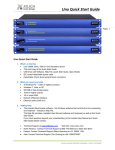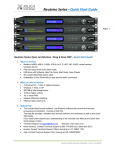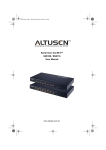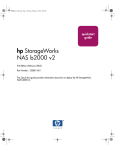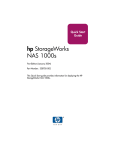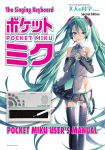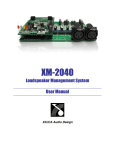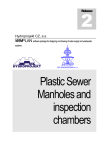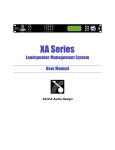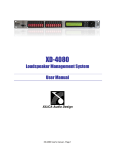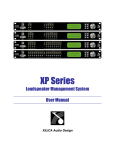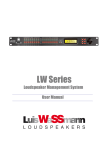Download Uno Series - Quick Start Guide 1
Transcript
Uno Series - Quick Start Guide Uno Series Apps Based DSP - Quick Start Guide 1. What’s in the Box The Uno Series processor model hardware device purchased This hard copy of the Quick Start Guide USB drive with Software, Help File, Quick Start Guide, Spec Sheets IEC socket detachable power cable Detachable 3.5mm Euro terminal block connectors 2. What you need to provide A Windows PC – 1GHz or higher processor Windows 8, 7, Vista, or XP 500 MB of free storage space 16 Bit or higher colours 4GB RAM minimum Network (Ethernet) interface Ethernet cable (Cat5 or 6) 3. Getting Help The included NeuConsole software - the Windows software that configures & controls the Uno processor - includes a Help File. That help file provides a detailed User Manual (software and hardware) as well as this Quick Start Guide. Plus see our web sites Product Tutorials for additional operational guidance and instruction – www.xilica.com - Products-Uno Series-Product Tutorials. If you have questions beyond those guidance resources please contact, Technical Support at [email protected] North America: Contact Technical Support at 905-770-0055 ext 3 (forwards to tech support cell phone after regular 9-5pm EST office hours) Europe: Contact Technical Support (Marco Koorstra) at +31 29940 1100 Asia: Contact Technical Support (Tim Cheung) at +86 13602279067 XILICA AUDIO DESIGN CANADA / EUROPE / ASIA – www.xilica.com Page 1 Web Site: www.xilica.com Uno Series - Quick Start Guide Important Safety Information 1. READ THESE INSTRUCTIONS All the safety and operating instructions should be read before the product is operated. 2. KEEP THESE INSTRUCTIONS The safety and operating instructions should be retained for future reference. 3. HEED ALL WARNINGS All warnings on the product and in the operating instructions should be adhered to. 4. FOLLOW ALL INSTRUCTIONS All operating and use of instructions should be followed. 5. DO NOT USE THIS APPARATUS NEAR WATER Do not use the product near water. For example, near a bathtub, washbowl, kitchen sink, or laundry tub, in a wet basement, or near a swimming pool, and the like. 6. CLEAN ONLY WITH DRY CLOTH Unplug the unit from the wall outlet before cleaning 7. DO NOT BLOCK ANY VENTILATION OPENINGS Slots and openings in the cabinet back or bottom are provided for ventilation, to ensure reliable operation of the limit and to protect it from overheating. These openings must not be blocked or covered. The openings should never be blocked by placing the product on a bed, sofa, rug, or similar surface. This product should never be placed near or over a radiator or heat source. This product should not be placed in a built-in installation such as a bookcase or rack unless proper ventilation is provided or the manufacturer’s instructions have been adhered to. 8. DO NOT INSTALL NEAR ANY HEAT SOURCES This Product should be situated away from heat sources such as radiators, stoves, or other products (including amplifiers) that produces heat. 9. DO NOT DEFEAT THE SAFETY PURPOSE OF THE POLARIZED OR GROUNDING-TYPE PLUG A Polarized plug has two blades with one wider than the other. A grounding-type plug has two blades and a third grounding prong. The wide blade or the third prongs are provided for your safety. If the provided plug does not fit into your outlet, consult an electrician for replacement of the obsolete outlet. 10. PROTECT THE POWER CORD FROM BEING WALKED ON OR PINCHED PARTICULARLY AT PLUGS, CONVENIENCE RECEPTACLES, AND THE POINT WHERE THEY EXIT FROM THE APPARATUS. 11. ONLY USE ATTACHMENTS/ACCESSORIES SPECIFIED BY THE MANUFACTURER. 12. USE ONLY WITH CART, STAND, TRIPOD, BRACKET, OR TABLE SPECIFIED BY THE MANUFACTURER, OR SOLD WITH THE APPARATUS. WHEN A CART IS USED, USE CAUTION WHEN MOVING THE CART/APPARATUS TO AVOID INJURY FROM TIP-OVER. Do not place this unit on an unstable cart, stand, tripod, bracket, or table. The unit may fall, causing serious injury to someone, and serious damage to the appliance. A unit and cart combination should be moved with care. Quick stops, excessive force, and uneven surfaces may cause the product and cart combination to overturn. 13. UNPLUG THIS APPARATUS DURING LIGHTNING STORMS OR WHEN UNUSED FOR LONG PERIODS OF TIME. For added protection for this unit during a lightning storm, or when it is left unattended and unused for long periods of time, unplug it from the wall outlet and disconnect the antenna or cable system. This will prevent damage to the unit due to lightning and power line surges. 14. REFER ALL SERVICING TO QUALIFIED SERVICE PERSONNEL. SERVICING IS REQUIRED WHEN THE APPARATUS HAS BEEN DAMAGED IN ANYWAY, SUCH AS WHEN THE POWER SUPPLY CORD OR PLUG IS DAMAGED, LIQUID HAS BEEN SPILLED OR OBJECTS HAVE FALLEN INTO THE APPARATUS, THE APPARATUS HAS BEEN EXPOSED TO RAIN OR MOISTURE, DOES NOT OPERATE NORMALLY, OR HAS BEEN DROPPED. 15. WARNING: TO REDUCE THE RISK OF FIRE OR ELECTRIC SHOCK, DO NOT EXPOSE THIS APPARATUS TO RAIN OR MOISTURE. Page 2 16. APPARATUS SHALL NOT BE EXPOSED TO DRIPPING OR SPLASHING AND NO OBJECTS FILLED WITH LIQUIDS, SUCH AS VASES, SHALL BE PLACED ON THE APPARATUS. XILICA AUDIO DESIGN CANADA / EUROPE / ASIA – www.xilica.com Uno Series - Quick Start Guide 4. Introduction and Description: Thank you Hello from everyone here at Xilica Audio Design and thank you for purchasing our Uno Series digital processor. Since Uno is setup and controlled by a host computer via Ethernet it is important that we get you connected and up and running as quickly and easily as possible. Thus the first portion of this Quick Start Guide is dedicated to getting the Uno processor and the NeuConsole software connected and operating. If you have any suggestions for making this quick start guide better in that or any regard please bring them to my attention at [email protected] and we will make those changes. Uno Series Digital Processor Designed in Canada and built on the audio performance reputation of our 40 Bit, Floating Point DSP Engine and High Performance 24 Bit Converters - Uno is an Apps based DSP that bridges the gap between fixed architecture and open architecture -drag & drop type processors. We call Uno a Hybrid architecture DSP. Simply download a pre-designed Uno App (device design) into Uno using the included NeuConsole software. There is a pre-designed Uno DSP App for just about every application and with input from users our web site apps library will continue to grow, future-proofing your Uno hardware investment. Uno is available in four I/O model configurations - 8x8, 8x16, 16x8 and 16x16 with Mic/Line input selection per input, 48v phantom power and premium grade mic pre-amps. Uno Series-N model versions provide Dante enabled network audio. Uno Series-AEC model versions provide 8 input channels with AEC and Uno Series-N-AEC combo model versions provide network audio and AEC for additional application flexibility. 5. Hardware: Front Panel 1. Power Status LED A blue Power Status LED will light to notify you that the Uno device is connected to a power source and switched to the ‘On’ position. 2. Network Status LED When the processor has an Ethernet cable / network cable connected the orange Network status LED on the front of the processor will light - once the processor initializes. If there is no Ethernet / network cable attached it remains off. When the processor and software are connected and communicating the orange Network status light will flash. 3. Input/Output Signal Indicators Page Each Input and Output channel has a dual colour LED signal indicator. Green for signal present at -40 dBu and Red at +17 dBu at the advent of analog clipping. 3 Note: When the Network status LED is on it does not mean that you have established a Network Connection – only that an Ethernet or network cable is connected to the processor. Proper Network Connection and Operation is indicated/displayed only in the software’s “Network View” page (see the Network View & Connection section of this guide). XILICA AUDIO DESIGN CANADA / EUROPE / ASIA – www.xilica.com Uno Series - Quick Start Guide Rear Panel (Top - Uno U1616 / Bottom - Uno U1616-N w network audio RJ-45 connectors) 1. 2. Power On/Off Switch Fuse Compartment Should you need to replace the fuse use a T-Series 2.5A-250v fuse. Ensure power to the device is disconnected when replacing the fuse. 3. Power Input Connector Insert the IEC plug connector end of the supplied cable into the rear panel of the Uno. Connect the AC end of the cord into an AC power source of the correct voltage and frequency (100-240 VAC, 50/60 Hz). 4. Ethernet Connector Uno utilizes a TCP protocol for communication with the host PC running the NeuConsole software. The port is a standard RJ45 (Ethernet) jack. 5. IP Reset Button. See the IP Reset / Reset Processor Network Settings section in this guide. 6. Logic Control Input/Output Port Utilizing twisted pair wire with an attached terminal block, you can use external signals to control parameters such as triggering presets within NeuConsole. 7. Analog Line Outputs Euro/Phoenix style terminal block output connections utilizing 3.5mm terminal block connectors (included). Use balanced, shielded audio cabling. Uno has eight (8) or sixteen (16) outputs depending on the model. 8. Analog Mic/Line Inputs Euro/Phoenix style terminal block input connections utilizing 3.5mm terminal block connectors (included). Use balanced, shielded audio cabling. Uno has eight (8) or sixteen (16) switchable Mic/Line inputs w 48v phantom power depending on the model. 9. Network Audio I/O Uno Series-N and Uno Series-N-AEC model versions include two RJ45 Dante enabled network audio connectors (not to be confused with the Ethernet connector). 16x16 I/O channels on one RJ45 connector/cable – one RJ45 for redundancy. 6. Install the NeuConsole Software: The USB drive included with each processor includes a full copy of the Uno’s NeuConsole software (including Microsoft’s .net framework component) or you can download the Windows 8, 7, Vista, XP compatible NeuConsole software from our web site and install on your computer (www.xilica.com). Determine which has the most recent software version and use that one. 4 When installing our NeuConsole software via our web site and where your PC software does not include Microsoft’s .net framework component - your PC will use the internet to secure a copy and continue the installation. If you have no internet connection you will need to use the included Xilica USB drive for your software installation as it also provides the Microsoft .net frame work component. Or contact Xilica tech support. Page XILICA AUDIO DESIGN CANADA / EUROPE / ASIA – www.xilica.com Uno Series - Quick Start Guide Note: The Microsoft installation program/process remembers what location you installed from the first time you load the NeuConsole software into your computer. This can cause issues if you try and load a new software Version (update) from a different location than the location originally used to load the NeuConsole software into your computer (USB, Internet Download, etc). Solution: Simply un-install the old NeuConsole software version in Control Panel before you update your software version each time. You won’t have any update issues and you won’t have to remember what location you loaded the software from previously or what the source was USB, Internet, etc. Make sure the NeuConsole Software version is the latest version (see “About” menu vs the web site). Make sure the processors Firmware version is compatible with software (view device firmware version in Network View). See firmware upgrade info on Page 11 - #15. If you have a personal Firewall setup on your computer, a Firewall popup window might be displayed during the software installation to ask whether users want to “Block” or “Allow” NeuConsole from accessing the network. Select “Allow” to continue installation. Once installed and working – close the NeuConsole software for now until you are instructed to open it again. 7. Download and Save Uno Apps (Device Designs): These are the pre-designed Uno Apps (Device Designs) or DSP schematics for a variety of applications that you will select from to use in your NeuConsole software and Uno processor in order to accommodate your specific DSP project design application. Before you begin working with the NeuConsole software and your Uno processor - go to our web site at www.xilica.com and from Products - Uno Series, select Uno Apps Library. Save to a folder in your computer one, some, or all of the pre-designed Uno Apps listed in the Uno Apps Library (.sxml files). In our example to follow we chose the Gain Sharing Auto Mixer Uno App. And we chose the U0808 version of that specific Uno App since we will be using the U0808 module in software and connecting to an Uno U0808 physical processor model in our example. NOTE: The Uno Apps processor version (U0808,U0816,U1608,U1616) must match the Uno software module you place in the design mode work area within the NeuConsole software in order to be able to import the Uno app into the software module. The same when transferring or saving your DSP work in software to a connected, physical Uno processor – the physical processor model must match the Uno software module and the Uno app processor version being used in the NeuConsole software. 8. Initial Device Connectivity: The Uno series of digital processors run on a network based infrastructure and are configured and controlled by a host computer via Ethernet using the NeuConsole software. A network connection can be made between your computer and Uno via (A) A DHCP enabled Router, Server, or Router/ Server/Switch/POE Switch combination as recommended and shown below or (B) A Non-DHCP enabled Direct connection or Indirectly via an Ethernet switch. Page 5 The primary difference between these two connection methods is the automatic IP address assignment / management that DHCP provides in (A). XILICA AUDIO DESIGN CANADA / EUROPE / ASIA – www.xilica.com Uno Series - Quick Start Guide (A) DHCP Enabled Router, Server, or Router/Server/Switch Combo Connection The Uno processor device boots up with DHCP enabled by default so with DHCP enabled routers and servers Uno will automatically obtain an IP address upon connection and power up. This may take a minute or two as the devices look for DHCP to obtain their IP address. Available DHCP is the recommended connection method. Where our NeuPanel Series wall controls will be used to remotely control the processor we recommend the use of a low cost router along with a POE switch. This combo will provide DHCP as well as power to the wall controls over their Ethernet cable by way of the switches POE feature (Power Over Ethernet). Note: Linksys routers/NetGear switches have tested well (D-Link routers have not). (B) Non-DHCP Enabled Direct or Indirect Connection When the processor is connected directly to a computer or indirectly via a switch or hub and DHCP is not available to assign IP addresses - the connection process is not automatic. (1) A Single Processor or Device in the Network Only - No DHCP Available Once no DHCP is detected - a single direct or indirectly connected processor/device will either try to connect using the IP address last assigned and stored in the device or attempt to revert to is default IP address of 169.254.128.128. Under some conditions the processor/device might refuse to relinquish its stored IP address or revert to its default IP address and thus refuse to connect. To simplify and speed this non-DHCP enabled connection we recommend - that before you power up your processor/device you should Reset the processor/device to its Default IP Address using the IP Reset Button on the rear of the device. Resetting the processor to its default IP address of 169.254.128.128 will have you connecting directly quickly and without problems when no DHCP is available. Please see - IP Reset Push Button / Reset Processor Network Settings instructions below on Page 7 below if you are creating a non-DHCP direct or indirect connection. Page 6 Note: Most modern computers can now detect a direct connection so you can use a straight through Ethernet cable for the direct connection (if there is a direct connection issue that persists then you might try a crossover type Ethernet cable). Note: Your PC should be set to “Obtain IP Address Automatically” – which is the common default setting in most PC’s. XILICA AUDIO DESIGN CANADA / EUROPE / ASIA – www.xilica.com Uno Series - Quick Start Guide IP Reset Push Button / Reset Processor Network Settings (DHCP not available) Follow these instructions prior to powering up the processor and opening the NeuConsole software. (a) At the rear of the processor you will see a small, round, recessed push button labeled “IP Reset”- just to the right of the Ethernet connector (looking from the back). You are able to push this reset push button inward using the point of a pen or a small pointed object. (b) Press the IP Reset push button inward and while holding it pushed in power up the processor device. (c) Wait 5 seconds after power up and then release the IP Reset push button. (d) Wait for the processor to power up completely (this will take a minute or so as it initializes and sets its default IP address). When complete the Network status LED will light and remain on. (e) You can verify your network connection on Page 8 & 9 – step #11. Note: Some Uno processors were manufactured with a different IP Reset switch that was hidden behind a removable cover on the rear of the processor. If yours is like that – Remove the small black cover on the rear of the processor near the Ethernet connector (remove 2 small screws). Looking from the back of the processor you will see a small black Reset Switch to the right of the Ethernet connector. Press this Reset Switch forward lightly with your finger and while holding it pressed forward power up the processor. Wait 5 seconds after power up and then release the Reset Switch (balance as above). Note: Although not as reliable, each connected device also has a software IP reset function. In Network View, right click the device and select Remote Reset. (2) Multiple Processor Devices Connected to the Network – No DHCP Available Where you will be connecting multiple Uno processors in your network and DHCP is not available, the user will have to manually assign unique static IP addresses to each processor or device. See – Manual Assignment of IP Addresses on Page 10 & 11 - #13 & 14. 9. Processor Device Connected and Powered Up: With your processor device/s connected as a network or directly to your computer, power on all devices. XILICA AUDIO DESIGN CANADA / EUROPE / ASIA – www.xilica.com Page (b) If the processor has an Ethernet cable / network cable connected the orange Network Status LED on the front of the processor will light - once the processor initializes. If there is no Ethernet / network cable attached it will remain off. Note: This does not mean that you have established a Network Connection – only that an Ethernet or network cable is connected to the processor. Proper Network Connection and Operation is indicated/displayed only in the software’s Network View page – see Network View & Connection below on Page 8 - #11. (c) Upon being powered up the processor will search for a DHCP router or server to obtain an IP address. If it locates DHCP it will connect quickly. If you are using a direct or indirect Non-DHCP connection you will have followed the instructions on Pages 6 & 7 and 10 & 11 to connect to a single processor or multiple processors – where DHCP is not available. (d) When the processor and software are connected and commands are being sent to the device the orange Network status LED will flash. 7 (a) On power up the processors blue Power Status LED will light. Uno Series - Quick Start Guide 10. Launch the NeuConsole Software: Upon opening the NeuConsole software you will be shown the “NeuConsole Startup” window. It provides 3 possible selections – New Design Project, Open Design Project, and Start “Network View” (Network View will also be available to you as a separate button located at the top right of the Project View/Design Mode work area page. 11. Network View and Connection: (a) Click Start “Network View” from the NeuConsole Startup window shown above. The Network View displays all processor and control devices connected to the network plus information such as the processor device model, a green, yellow or red network connection indicator, the IP address, and the devices Firmware version (as shown below). (b) In Network View as shown below - you should now see your processor device model connected to the network router block and the Network Connection Indicator to the left of the processor device model should be Green/On (meaning it is connected and operational). Page 8 (c) Note the Firmware version of the processor or device (as in version 4_3_0 below left). Any device firmware / software incompatibility will be indicated in Network View with either a Red warning symbol (connected but firmware is not compatible - must upgrade device firmware) or a Yellow symbol (connected and may function but firmware is not a recommended version) – both shown below. See Firmware Upgrade on Pg 11 - #15. XILICA AUDIO DESIGN CANADA / EUROPE / ASIA – www.xilica.com Uno Series - Quick Start Guide (d) If your processor and software have Not connected properly you will see a Red or Yellow connection indicator to the left of the processor or device model in Network View indicating a connection or operational problem. Network Connection Indicators Green (On) - Connected and operational. Yellow – Connected but Not Operational. Red (Off) - The processor is offline – not connected – no communication between the NeuConsole software and the processor. Check cables and connections. Note: This could be a temporary offline interruption if the processor is busy performing a firmware upgrade, re-booting, searching for DHCP or defaulting to its default IP address. 12. Connection Problems? While in Network View if there is a Yellow network connection indicator next to the processor device model the device is connected/online - but Not Ready / Not Operational. XILICA AUDIO DESIGN CANADA / EUROPE / ASIA – www.xilica.com Page (c) Those connection solutions resolve 99% of any Yellow indicator connection issues but to assist further, when the indicator is Yellow you can hover your cursor over the device and there is a pop-up Tooltip message to tell you the kind of issues it has detected. (d) A few message and solution examples below. Message: Device not ready. Solution: Wait a minute or two till the device is ready and it should then connect and the indicator turn Green if successful. Solution: If the indicator remains Yellow, close the NeuConsole software and then re-open. Or Reset the processor. Message: Device Schematic Not ready. Solution: The processor has already been loaded with a DSP design. Give the connection process a minute to connect and if it does not connect close the NeuConsole software, open it again, select Start Network View and you should now see that the processor is connected and operational - as indicated by the Green network 9 (a) The three most common reasons for this Yellow connection indicator is the result of (1) A nonDHCP connection where multiple processors are in use and each device needs a unique IP address manually assigned to it (2) Where a non-DHCP direct or indirectly connected - single processor device is not reverting to its default IP address and/or is holding onto its previous address and (3) Software/Firmware incompatibility. (b) Solutions – (1) See instructions on Page 10 &11 - #13 & 14 – Manual Assignment of IP Addresses (2) See Page 6 & 7 to reset the processor to its Default IP address and (3) Check device firmware version in Network View & perform a processor Firmware Upgrade – as described on Page 11 - #15. Uno Series - Quick Start Guide connection indicator to the left of the processor device model. Solution: If not connected – reset the processor – see IP Reset Button/Reset Processor on Page 6&7. Message: DSP Processing Error. Solution: This could be a bad DSP Design schematic. You may need to reload the DSP schematic and restart and/or restart device to reset its DSP chip. Message: Error in Firmware Upgrade. Solution: It will print out an error code when you hover your cursor over the device in Network View (Do Firmware Upgrade again). 13. Manual Assignment of IP Addresses To Multiple Devices – No DHCP: Unique, manually assigned/static IP addresses are required for each processor or device. (Each processor or device indirectly connected to the PC via a network switch or hub) Note: Make sure your computer is set to “Obtain IP Address Automatically”. We will set your computer’s static IP Address after changing the IP Addresses on all the processors and devices first. To manually assign static IP addresses to multiple processors and devices, (a) Connect device number one directly to your PC, reset its IP address as described on Page 6&7 (IP Reset) and establish a connection between the device and your PC/NeuConsole software. (b) Next, in Network View as shown below left - right click the connected processor or device and select “Device Setup”. Page (c) With the DHCP button disabled, assign the unique IP Address of 192.168.1.X to the first processor device – where X is a unique number between 0 & 255. (d) When finished – Select “Apply” to save changes and then “Done” to exit. (e) Complete steps 1 thru 4 above for each subsequent processor or device so that each is assigned its own unique static IP address (example – might be 192.168.1.180 / 181/ 182/ etc. (f) Your devices will appear Offline until you assign a static IP address for your PC as described below. (g) Once all processors and devices have their own unique IP address we will do the same for your PC in #14 below on Page 11. 10 In the Network Properties window as shown at the right - select “Change Network Configuration” in order to disable DHCP and to insert IP addresses manually (it also provides two built in test procedures, device security, and device information). XILICA AUDIO DESIGN CANADA / EUROPE / ASIA – www.xilica.com Uno Series - Quick Start Guide 14. A Static IP Address for your Computer - Multiple Devices – No DHCP: In this section, we will be navigating through Microsoft Windows to determine your home networking information as it applies to manually assigning a unique static IP address to your computer. (a) The first step is to open the 'Start Menu' and select Control Panel. (b) Click View Network Status and Tasks under the Network and Internet header as shown at the right. (c) Click on Change adapter settings on the left most tab. (d) Left-Click on Local Area Connection and click the Properties button. Select Internet Protocol Version 4 (TCP/IPv4) then click Properties to access the manual IP settings. (e) Set up your IP address to be 192.168.1.X where the X can be any value from 0 – 255 – but unique from the other devices that you already manually assigned unique IP addresses to. (f) Use the following settings for your PC’s unique static address: IP Address: 192.168.1.X (Example – IP might be 192.168.1.185 based on my Subnet Mask: 255.255.255.0 unique device addresses above) Gateway: 192.168.1.1 DNS Servers: 192.168.1.1 (g) If you set up your devices as per step 13&14 on Page 10 & 11 above, you will now see them appear online and connected in Network View in the NeuConsole software. 15. Firmware Upgrade to Processor Device: Once you have the processor device and the NeuConsole software connected and operational and before you start work on a DSP design project - make sure your processor has the latest firmware installed (www.xilica.com – verify, download latest firmware, save file to your PC and proceed below with firmware upgrade procedure if required). Note: You must not disrupt power during the Firmware Upgrade process. In Network View as shown below left – Right click the device, Select “Firmware Upgrade” from the menu and follow the instructions. As indicated during the firmware upgrade procedure – a firmware upgrade will erase all saved data on the device. Thus perform this procedure before you load a complete DSP Design Project into the processor device (or re-transfer/save a saved project design file to the processor device after the processor firmware upgrade is complete). Page 11 XILICA AUDIO DESIGN CANADA / EUROPE / ASIA – www.xilica.com Uno Series - Quick Start Guide 16. NeuConsole Software: (Project View/Design Mode) You are able to work with the NeuConsole software without being connected to an Uno processor (Offline) but for the purpose of this guide example we have established a network connection to the Uno processor first before beginning to work on a New Design Project. In the following example the processor is connected and operational. New Design Project If you are still in the Network View window – Go to “File” at the top left and select “New Project” in order to begin a new DSP design project. If you have just opened the software - from the NeuConsole Startup window as shown on the left you can select “New Design Project” in order to begin a new DSP design project. Project View/Design Mode Work Area Either will open the Project View / Design Mode work area page as shown below and as identified by the white dotted alignment work area. 12 See the Project, Design Mode, and the red Switch to Online Mode headings & buttons at the top left and center of the work area (if not connected to the processor the red Switch to Online Mode button would not be visible). See the grey Network View (Project View) button at the top right above Component Properties. See the Component Libraries menu on the far left and the Component Properties menu at the far right of the Project View/Design Mode work area page as shown below. Page XILICA AUDIO DESIGN CANADA / EUROPE / ASIA – www.xilica.com Uno Series - Quick Start Guide Note: Once you are in Project View working on a DSP design you are able to switch back and forth between “Project View” and “Network View” by selecting the grey Network View / Project View button at the top right of the work page area. Processor Module From the System Components menu under Component Libraries on the left, click and drag the Uno processor module you are going to use for your application and this DSP design project onto the Project Views white work area. For our example we chose the Uno U0808. You will notice that the Uno U0808 processor module placed in the project view/design mode work area is a light see through red color. Processor Module / Project View Page 13 (a) With the red Uno U0808 DSP module placed in the Project View work area we can create the overall project view of the application design by dragging source and other components into the work area and wiring/connecting them to the processor module to then represent the other physical audio components that are connected to the physical Uno processor. XILICA AUDIO DESIGN CANADA / EUROPE / ASIA – www.xilica.com Uno Series - Quick Start Guide (b) As shown below, we have added source and playback audio components. We are able to label the Uno processor and audio components as well as connecting cable types and ID’s by clicking them and using the Component Properties menu at the right. If you click the white work area to open the Project Information section in the Component Properties menu you can type a project description (project name) and project notes into that section of the menu. If you select Project in the top menu and select Export Bill of Materials to File you can create/print a bill of materials listing the Uno components along with the cable types and other information from Project View. Map Physical Device (a) Next, with the red Uno U0808 processor module for this application placed in the Project View/Design Mode work area as shown above (and when the processor device is connected to the NeuConsole software) we need to Map or connect the Uno’s software processor module in the work area with the actual physical Uno processor device that is connected to the PC. (b) To Map Physical Device, right click the red Uno U0808 processor module in the work area. Select “Map Physical Device” as shown at right and select the processor device model you are working with from the drop down list. Once done as shown below on page 15, notice that the processor module in the Project View/Design Mode work area has turned from a light see through red color to solid red – indicating Map success. Importing a Pre-Designed Uno App (Device Design) into your Processor Module Page 14 (1) Again, right click the red Uno U0808 processor module in the Project View/Design Mode work area and select “Import Device Design from File” - as shown below left on Page 15. XILICA AUDIO DESIGN CANADA / EUROPE / ASIA – www.xilica.com Uno Series - Quick Start Guide (2) That will take you to the folder where you saved your pre-designed Uno Apps early on in this quick start guide or you can browse to the file where you saved them. Uno Apps are .sxml files (New Project). Saved DSP design projects are .pjxml files (Open Project). (3) Select the pre-designed Uno App - device design (.sxml file) you want to use for this New Design Project application and then click “Open”. We chose the U0808-Gain Sharing Auto Mixer Uno app (the Uno app you choose must match the processor module you are using. For example, you cannot load a U1616 pre-designed Uno App into a U0808 processor module and device). (4) Wait a few seconds then double click the red Uno U0808 processor module in the Project View/Design Mode work area to view the app schematic. (5) As shown above, the pre-designed Uno App – Device Design schematic we imported now resides in the U0808 processor module in the work area and when opened it reveals all of its DSP modules and the DSP module schematic layout. 15 New to NeuConsole v5.2.1 – We support printing of Project System Overview and Device Schematic Design to JPEG files for documentation purposes. See the Print Project to JPEG File printer symbol button to the right of the Zoom slider at the top right. Page XILICA AUDIO DESIGN CANADA / EUROPE / ASIA – www.xilica.com Uno Series - Quick Start Guide (6) Once the Component Libraries menu on the left is not required it can be minimized to provide more space to arrange items. The Component Properties menu on the right can remain open until you label all your wired I/O Source and Destination connections (described on Page 17 #17). Then it too can be minimized. Both shown below. (7) Double clicking on any DSP module opens that module so you can make parameter adjustments to each DSP module as required – as shown below. (8) Double clicking on the Analog Input DSP module provides parameter access to the master input Polarity, Mute, Digital Trim & Meters. Plus, via a secondary button located within the opened Input module, the processors Mic/Line Pre-Amp parameter controls – as shown below. Page 16 (9) Click the grey “Mic/Line Pre-Amp Setup” button in the opened Analog Input module (above left) to open the processors Mic/Line Pre-Amp module (above right) to make parameter adjusts to the processors Mic/Line Pre-Amp - Mic/Line selection, phantom power and analog trim. XILICA AUDIO DESIGN CANADA / EUROPE / ASIA – www.xilica.com Uno Series - Quick Start Guide 17. Label DSP Module Source and Destination Connections: During or after completing your parameter adjustments - spend some time labeling the DSP module I/O Source and Destination connections (as well as labeling possibilities in Project View). Point & click on any wire to highlight it then type a new label name in the Component Properties menu / Link Information Source and Destination label area at the right of the work area. As shown in the Matrix mixer at the far right - Source/Destination labels will populate opened DSP modules – like the matrix mixer- see Hall A / Hall B labels. 18. Save Project: (a) Click the “Save Project” Disc located to the right of the zoom control at the top of the Project View work area to “Save Project As” or “Save” your DSP design project (each time a DSP parameter adjustment or any change is made the Save Project Disc will re-appear) OR Select “Save Project As” under the File menu at the top left of the application to name and save your design project and “Save Project” to save as you work. Note: This saves the DSP design project you are working on to your PC (not to the physical processor device). See Switch to Online Mode below to accomplish that. (b) We recommend that you Save As the project file twice. Once to create a Master File and a second time to create a Work File. Continue working with the Work File, update the Master File appropriately and the Master File is protected. At the end of the project – continue running the system with the Work File, rename it to Master Ver 2, or other. 19. Switch to Online Mode: (Transfer/Save DSP design project to the physical device) Once your DSP design project parameter adjustments are completed (and saved to your PC) you can transfer/save your work to the connected physical processor device. To do this, (a) Click the red “Switch to Online Mode” button at the top of the Project View / Design Mode work area page – as shown below (not visible if a network interface is not detected – you are working Offline) Page 17 (b) This button selection actually performs two functions at the same time – it transfers or saves your DSP design project to the connected processor device and that processor is now Online and active (live). XILICA AUDIO DESIGN CANADA / EUROPE / ASIA – www.xilica.com Uno Series - Quick Start Guide (c) As shown below, follow instructions provided (save project if not already saved, etc). An Hour Glass symbol and the prompt - Preparing Devices. Please Wait… will appear once the process begins of transferring / saving your DSP design project to the physical processor device. (d) Any problems – check Auto Warning Messages in Network View regarding any Firmware Incompatibility with Software (will not load your design into device if any incompatibility). When complete, (e) Note below that the Design Mode label at the top of the page has changed to “Online Mode” and that the “Switch to Online Mode” button has been re-named “Switch to Design Mode”. Thus you are able to quickly switch back and forth between Online Mode and Design Mode. Page (g) Note: You can make parameter adjustments to the DSP modules while in Online Mode. When you do, upon switching back to Design Mode you will be asked “do you want to copy the Online Mode device parameter changes back to your project (file) – yes or no”. So you can make all kinds of parameter adjustment changes to the DSP modules in Online Mode, hear their effect live, and not affect the related DSP design project file as saved on your PC if you select “No” from that menu. Or select Yes to modify your project file and continue working or Yes and Save As immediately to save the changed processor settings to a brand new project file. Careful here not to write over your saved project file if you do not mean to. 18 (f) Note above that the tool bars at the top of the Online Mode work area page, the opened DSP design layout and the DSP modules are now Red (not blue) indicating that you are in Online Mode. XILICA AUDIO DESIGN CANADA / EUROPE / ASIA – www.xilica.com Uno Series - Quick Start Guide 20. Working Offline: Of course you can import an Uno App, work on a DSP design project and save it to a file while “Offline” – no network interface detected / no processor device connected, no Map Physical Device action taken, and without transferring your work to the processor device right away. Then later, connect processor, Map Physical Device, open your saved project, and transfer/save your saved DSP design project file to the processor device by selecting the “Switch to Online Mode” button. 21. Open Design Project: The “Open Design Project” selection in the NeuConsole Startup window or Open Project as selected under File is where you open or access previously worked on and saved DSP design project files - as compared to creating a New Design Project as we did in this guide above. In both cases the saved DSP design project file (.pjxml file) once opened will appear in your Project View/ Design Mode work area – along with the specific Uno processor module used in the saved design project. Double click the processor module in the work area to view the saved DSP design project / schematic layout. Double click DSP modules to open them and make parameter adjustments as required. Save your work as you go and the balance of your work operations are the same as described above in New Design Project. 22. Component Properties Menu: The Component Properties menu on the right side of the Project View work area normally provides the means to alter specific characteristics of each individual DSP Module and to make name changes when the NeuConsole software is used in conjunction with a Neutrino Series DSP only. In Uno, fewer component properties can be named and changed but included is the ability to label all DSP module I/O Source & Destination wire points & those labels then populate DSP modules. Plus labeling for the Uno module and audio components in Project View (see Pg 14). 23. Open Device: (Quick Access to a Programmed Processor Device) XILICA AUDIO DESIGN CANADA / EUROPE / ASIA – www.xilica.com Page (a) Connect to the processor device. (b) Open the NeuConsole software. (c) From the NeuConsole Startup window select Start “Network View”. (d) In the Network View window as shown at the right - make sure the network connection indicator to the left of the processor device model is Green (connected and operational). (e) At the bottom see the “Open Device” button – as shown at the right. (f) Select “Open Device” to open the DSP design project as saved on the connected physical processor device. 19 If you are connecting to a processor device that already has an Uno DSP Design Project programmed and saved into it (that processor is likely installed and operating) and you need quick access to the physical processor devices DSP design schematic to check out its settings or to make new “live” DSP module parameter adjustments, Uno Series - Quick Start Guide (g) Once open - the processors DSP is active (live) - just as it was in Online Mode. And as it is when in Online Mode - the color scheme in Open Device mode is Red (instead of blue) as a reminder. (h) Double click DSP modules to open and make parameter adjustments to the DSP modules in real time. Note: Any parameter changes you make from “Open Device” mode will only be maintained in the processor device itself and can Not be saved to the specific DSP design project file as saved on your PC. Thus parameter changes can be made but no one can accidently alter the original saved DSP design project file while working in the Open Device operating mode. But, you can Export and save any processor setting changes as a reference file (only) by right clicking the processor device in Network View and selecting Export Device Design. You are not however able to use that exported reference file to create a new DSP design in Uno – it is a reference only of setting changes made to the processor in Open Device mode. You must be working with that exact specific DSP design project file as saved on your PC and working in Design Mode and Online Mode in order for the parameter changes you made to the physical processor device while in Open Device mode to be accessible and savable to the project file - and there are safety reminders and permissions required in order to accomplish that to protect your original as-saved design project file. Be careful. Note: Changes made in Open Device mode can also be viewed when in Online Mode – if you choose “No” in the permissions window after selecting the Switch to Online Mode button. 24. Uno Series DSP - Remote Control: The Uno processor can be remotely controlled using its NeuConsole software GUI, with the logic input/output ports, using the optional NeuPanel Series - Mini and Touch model programmable wall controls, with your own Android device using our free NeuPanel/Touch software, via your iOS, OSX, or Android device using the browser control feature in our optional Centro SM1 site manager, or any third party controller. See www.xilica.com for spec sheets and information or contact Xilica using the contact information on the web site or that provided here on Page 1. 25. Additional Operational Guidance: That should get you connected, operational, downloading pre-designed Uno Apps into the software and processor, creating new design projects, opening and working on saved DSP design project files, transferring/saving your DSP design projects to the processor, and working in Online Mode and Open Device mode. For more detailed operational guidance please see the detailed User Manual that can be viewed in the NeuConsole software” Help File”; information saved on the USB drive packaged with each processor (this Quick Start Guide can be found in both locations as well); our web site Product Tutorials at www.xilica.com - Products-Uno Series-Product Tutorials; or contact Xilica via our web site or this guides contact information on Page 1. Unoquickstartguide-v1.1-fw5.2.1-sw5.2.1 XILICA AUDIO DESIGN CANADA / EUROPE / ASIA – www.xilica.com Page Kind regards, Barry Steinburg [email protected] 20 Again, from everyone here at Xilica Audio Design, thank you for your support.





















